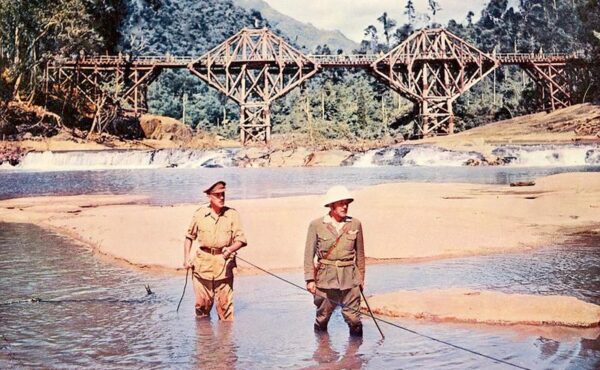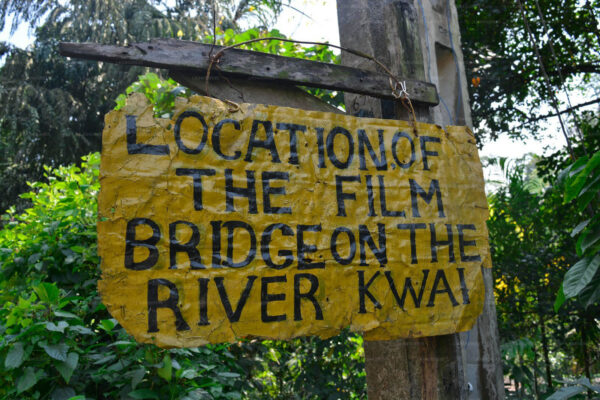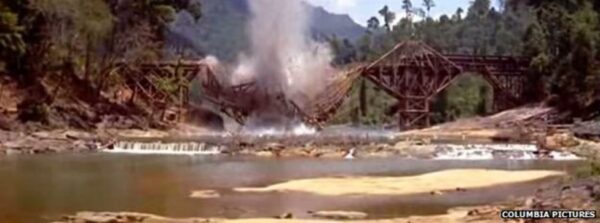Kithulgala – iconic location of the Gem of the Silver Screen “The Bridge on the River Kwai” – By Arundathie Abeysinghe

 Having won seven Academy Awards, “Bridge on the River Kwai” directed by British Film Director David Lean (Sir David Lean 1908-1991) was an epic war film shot in Ceylon in 1957 aided by Chandran Rutnam (Sri Lankan film maker and entrepreneur) who collaborated local links. Adapted from the 1952 novel by Pierre Boulle (that goes by the same name) the movie was filmed in *Kithulgala, in *Ratnapura District, perched on the western edge of Sri Lanka’s Hill Country. A makeshift bridge was constructed over the *Kelani River for the movie, although, nothing remains at present, except the concrete foundations of the Bridge (as the railway bridge utilized in the movie was blown-up as part of the film sequel).
Having won seven Academy Awards, “Bridge on the River Kwai” directed by British Film Director David Lean (Sir David Lean 1908-1991) was an epic war film shot in Ceylon in 1957 aided by Chandran Rutnam (Sri Lankan film maker and entrepreneur) who collaborated local links. Adapted from the 1952 novel by Pierre Boulle (that goes by the same name) the movie was filmed in *Kithulgala, in *Ratnapura District, perched on the western edge of Sri Lanka’s Hill Country. A makeshift bridge was constructed over the *Kelani River for the movie, although, nothing remains at present, except the concrete foundations of the Bridge (as the railway bridge utilized in the movie was blown-up as part of the film sequel).
The movie describes the tale of a group of Japanese war prisoners who were forced to construct a bridge over *River Kwai to link Bangkok and Rangoon.
Film stars William Holden (Hollywood’s most durable and engaging star), Alex Guinness (British) and Jack Hawkins (British) starred in the movie. Several villagers of Kithulgala too played roles in the movie.
In March, 1958, “The Bridge on the River Kwai” swept seven Academy Awards including the award for the “Best Picture”. The film was considered “culturally, historically or aesthetically significant” and has been selected for preservation in the National Film Registry by the United States Library of Congress. The movie, exploring the lives of British prisoners of war (POWs) being held at a Japanese prison camp in Burma (present Myanmar) was filmed in Sri Lanka (former Ceylon) in Kithulgala, well-known for its rainforests and breathtaking vistas.
The blockbuster movie “Bridge on the River Kwai” became globally renowned and the hamlet Kithulgala well-known for its rainforests too became renowned worldwide. Currently, Kithulgala is globally renowned for adventure sports, especially *white-water rafting.
Although the movie has the historical setting of the construction of the Burma Railway during the period, 1942–1943, the plot and characters of Boulle’s novel including the screenplay are completely fictional based on some incidents that occurred during that period.
According to locals, the Bridge that was utilized to shoot the movie during 1956-1957 had been dismantled once filming was concluded in order to protect the ecology of the environment. Although, Kelani River was a slower-moving waterway during the shooting of the film than at present, film director David Lean is said to have almost drowned when the river swept him away during a break (during filming).
The fictional Bridge on the River Kwai (present Kanchanburi, Thailand) is a representation of an actual event during World War II when a British commando team was marshalled and trained in Ceylon to carry out a mission to destroy a strategic railway bridge constructed over River Kwai by the Japanese war machine in 1942/43. Captured British, Dutch as well as American troops who were part of the labor force were utilized to construct the Bridge.
The commando team assigned for this significant task had been trained in Ceylon, a former British colony which housed the headquarters of the British Headquarters for the *South-East Asian theatre headed by *Lord Mountbatten. Headquarters of the mission included military buildings on the banks of the *Mahaweli River at Peradeniya in Kandy which later became part of *University of Peradeniya.
Residents of Kithulgala are appreciative about the shooting of an Oscar-winning movie in their home town and several residents have collected some souvenirs of the movie location. Chandralatha Jayawardena, a resident of Kithulgala, a child star who played a role in the movie has preserved mementoes from the film in her house.
At present, the filming location of the movie is indicated by a discreet, rusted piece of metal on which directions to the location have been painted.

Recently, Sri Lanka Tourism Development Authority (SLTDA) has considered installing a replica of the Bridge that was utilized in the film to promote interest in Kithulgala among local and foreign tourists in a bid to promote the location as a tourist attraction.
Film buffs travel to Kithulgala to view the cinematic location. The bridge in Thailand (River Kwai Bridge) is also a popular location.
During a visit to Kithulgala, tourists also indulge in adventure activities such as white-water rafting, trekking, bird watching and visiting archaeological sites such as *Beli lena.
Tips:
Visit Kithulgala during the peak season of January to March, as the climate is cooler and has less rainfall.
It is best to watch the movie first before visiting the location.
Image courtesy: COLUMBIA PICTURES & sundayobserver.lk
- Kelani River – One of the major rivers in Sri Lanka and is 145 kilometers long.
- Kithulgala – A small town located in the wet zone to the west of Sri Lanka situated approximately 92 kilometers from Colombo often spelt as “Kitulgala” is a spectacular hamlet well-known due to the Academy Award-winning film ‘The Bridge on the River Kwai’ directed by David Lean and filmed on the Kelani River. At present, the only evidence of the filming scene is the foundation of the Bridge used for filming. According to locals, the submerged train compartments of the train (used for filming) had been found at the bottom of the *Kelani River at Kithulgala many years ago. Currently, Kithulgala has become the island nation’s number one attraction for adventure holiday makers, foreign as well as local tourists, especially those who indulge in white water rafting or enjoy a picnic in a delightful setting. “Kithulgala” is derived from the words “Kithul” palmtree (Caryota urens) and the common Sinhalese toponym suffix “gala” for “boulder” or “rock”.
- Lord Louis Mountbatten – Admiral Lord Louis Mountbatten popularly known as Lord Mountbatten was appointed as the Supreme Allied Commander of *South East Asia Theatre in 1943. He set up his headquarters in Kandy.

- Mahaweli River – Sri Lanka’s longest river, 335 kilometers in length with a drainage basin of 10,448km2.
- Ratnapura District – A major town in Sri Lanka and the capital of Sabaragamuwa Province. Ratnapura is the traditional center for gem trade.
- River Kwai – Kanchanaburi, a town in west Thailand, in Myanmar border is home to the famous Bridge over River Kwai. The railway line crosses over the River Khwae Yai via the Death Railway Bridge. During World War II, Japanese constructed the meter-gauge railway line from Ban Pong, Thailand to Thanbyuzayat in Myanmar (former Burma) passing through the scenic Three Pagodas Pass spanning approximately 400 kilometers (250 miles). The construction of the Bridge was carried out using prisoners of war (POWs) and Asian slave laborers in unfavorable conditions. The construction commenced in October 1942 was completed within a year. As a result, three sections of the River Kwai Bridge were destroyed. The present bridge has two of its central spans rebuilt and the original parts of the bridge are now displayed in the War Museum. Due to the difficult terrain, thousands of laborers lost their lives. According to folklore, one life was lost for each sleeper laid in the track. At the adjacent Kanchanaburi War Cemetery, approximately 7,000 POWs, who sacrificed their lives in the railway construction are buried. Another 2,000 are laid to rest at the Chungkai Cemetery (also known as “Chung Kai War Cemetery”, a war cemetery in Tha Ma Kham near Kanchanaburi, Thailand). Allied Forces bombed the iron bridge in 1944.
- Sabaragamuwa Province – One of the nine provinces of Sri Lanka located in the south-central region of Sri Lanka.
- South East Asian Theatre – South East Asia Command (SEAC) was the body set up to be in overall charge of Allied Operations in South East Asia during World War II.
- University of Peradeniya – A leading state university in Sri Lanka consisting of eight faculties, University of Peradeniya is the largest university in Sri Lanka. Originally established as “University of Ceylon”, in 1942, University of Peradeniya is the most spectacular university in Sri Lanka and one of the most breathtaking universities in the world. The architecture of the University is a blend of Kandyan architecture as well as modernity. Sir Ivor Jennings served as the first Vice Chancellor of the University of Peradeniya. A concept of Sir Ivor Jennings, the architect of the University of Peradeniya, the University is situated in Peradeniya in a spectacular environment at the foothills of Hanthana Mountain Range.
Kitulgala Beli Lena Cave – archaeological treasure trove By Arundathie Abeysinghe – Nov 8, 2020
White Water Rafting in Kitulgala – adventure capital of Sri Lanka By Arundathie Abeysinghe – Nov 30, 2020







